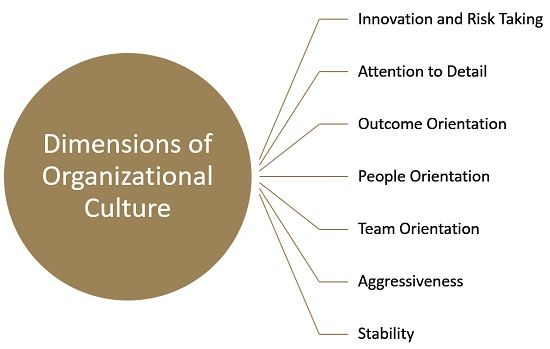Definition: Organizational culture, as the name suggests is the culture inherent in the organization, which determines its internal atmosphere and the overall personality.
It refers to a pattern of accepted and learned behaviour, which are mutually shared and are taught to the new joiners as to how to perceive, think and behave in the organization. Moreover, it develops a sense of identity and uniqueness in the employees.
Organizational Culture is a system of common values, beliefs, ideas, preferences, assumptions, code of conduct, unwritten rules, priorities, and principles, that guides employees of the appropriate and inappropriate behaviour.
Dimensions of Organizational Culture
- Innovation and Risk-Taking: The extent to which employees are motivated to become innovative, willing to experiment and take risks.
- Attention to detail: The standard to which organizations workers are expected to work on precision, analysis and pay attention to details.
- Outcome Orientation: The degree to which the company’s management is oriented towards the outcomes instead of the strategies and processes employed to achieve them.
- People Orientation: The extent to which the impact of the decisions made and the consequences of these decisions on people of the organization are considered by the management, through greater participation. Hence, it is all about the degree of value and respect for people working in the organization.
- Team Orientation: The extent to which relevance is given to effective teamwork in comparison to the individual efforts and contributions to the organization, by way of collaborative problem-solving.
- Aggressiveness: It is all about the employee’s approach to the work, i.e. the extent to which employees show competitiveness towards work, instead of having a casual approach.
- Stability: It determines how open an organization is, with respect to change. Moreover, it is also associated with the company’s status quo, i.e. to what extent the company gives preference on maintaining the statement of affairs.
The above-mentioned dimensions interact dynamically so as to build an organizational culture, of which one or more is in a continuous state of change depending on various factors.
How do employees learn Culture?
Employees get to know about the culture of the organization through various means such as ceremonies, rituals, stories, languages, symbols etc.
Levels of Organizational Culture
Organizational Culture has a very strong impact on the people in the organization governing the way they interact, dress, behave and perform their tasks. It can be a source of an organization’s competitive advantage. Let’s take a look at the levels of organizational culture:
- Assumptions: It indicates the basic beliefs concerning human tendency and reality, but it cannot be read and understood.
- Beliefs and Values: It refers to the common principles, standards and goals of the organization, reflecting the greater level of awareness.
- Artefacts: It determines visible or say tangible features of the organizational culture, but are usually taken for granted.
The organizational culture cannot be seen or touched, though it influences the behaviour, thinking and performance of all the employees. Hence, it is abstract, which the members of the organization can sense it.
It answers questions like – How tasks are supposed to be completed? What is appropriate in the context of an organization? It is acceptable to question the decision of managers?
Furthermore, it constitutes the distinct social and psychological environment of the organization. When these are combined, they create a climate which acts as a guide to communicate, plan and make decisions effectively.
It encompasses shared beliefs and values designed by the company’s top executives, which is passed on down the line, i.e. conveyed and implemented through various methods, which helps in determining employee’s perceptions, behaviour and understanding.


Leave a Reply